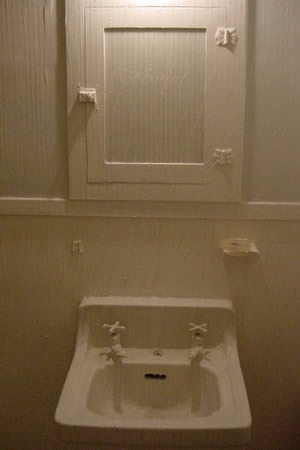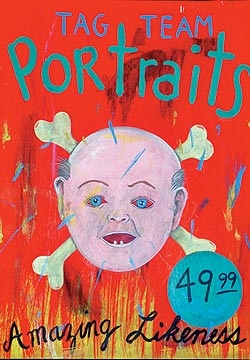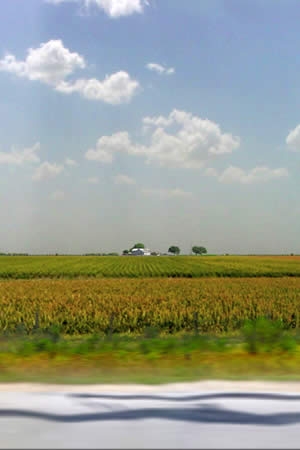Feature: Reviews
STOLEN ~ properties
- Sala Diaz
- San Antonio, TX
- June 29 - August 19, 2001
San Antonio. I am certain most folks think Alamo before art in the context of this South Texas town. However, even while entrenched in its omnipotent history, San Antonio presents an attuned ear to contemporary art. Nestled in the working class neighborhood referred to as Southtown, the alternative art space Sala Diaz is far from ordinary (as if one could describe anything in San Antonio as ordinary). From outside, the gallery looks more like a run-down cottage waiting for the next westward wind to topple its fragile frame than a local hotbed of critical discourse and innovative art exhibitions. For the last six years inside this stilt-supported artist run gallery, top-notch shows of local, national, and international artists have found a home amidst the Lone Star obsession with Davy Crockett and General Santa Ana.
The current show undoubtedly falls within this lineage. Guest curator, Jennifer Davy (a former assistant at Refusalon Gallery in San Francisco and currently an MA candidate in art history at the University of Texas San Antonio) has pulled together a medley of artists in a group exhibition entitled STOLEN ~ properties. Acting as a self-identified “intellectual thief,” Davy plundered the studios of eight artists from Los Angeles to Baltimore, pilfering works that at first glance seem to have less in common than the random items of a pawnshop – which just may be the point. Rather then picking a theme then choosing the works, Davy set forth to “steal” the premise of her show from the ideas inherent in the works themselves. In effect, these stolen prizes (in thieving lingo) are Davy’s score.
Included in the show are San Antonio-based artists Jennifer Agricola, Guy Hundere, Lawrence Jennings, Juan Ramos, and Celia Mendoza; from Los Angeles, Brandon LaBelle and Steve Roden; and Hugh Pocock from Baltimore. Traversing a variety of media, Davy is hardly criminal in her selections. While there may be nothing visually concrete to link this group of artists, the individual pieces reveal a resounding sensitivity to the artists’ immediate surroundings. From skateboards and paint can lids to masking tape, the works offer material clues to their respective content, subject matter and structure. Indeed, many of the works carry a conceptual sensibility of “stealing” the obvious.
Materiality plays an integral role in shaping many of the works in this show. Claiming the gallery’s bathroom, Jennifer Agricola painstakingly applied masking tape to the entire room. Sink, toilet, shower curtain, floor, ceiling, and walls are completely covered in strips of thin beige masking tape concealing any trace of the bathroom’s former dilapidated self. Equalized and neutralized by this “wallpaper,” the room becomes a disinterested space of artifice – the room is literally and figuratively masked.
Steve Roden and Lawrence Jennings take the random effects that occur within particular parameters of the seemingly mundane to form their work. Roden’s audio piece Chair (A Subscape) (1999) extracts various noises made on a metal chair to create a symphonic landscape of sounds. Likewise in Boardslide, Jennings appropriates a skateboarding trick as the next uber-painting process. When mounted on a wall, the scratched and marked underbelly of a skateboard can easily be transposed into a graffiti-like abstract painting.
Juan Ramos’ series of black and white digital prints and the accompanying video, Ghost Stories, (2001) use San Antonio as a backdrop. Superimposing stylized drawings of local Latino residents – friends of the artist as well as those only known by their ubiquity in the community – over slightly obscured photographs of the city, Ramos literally renders these figures as “characters.” A comic book aesthetic folded into reality, Ramos’s images are sincerely illustrative, bypassing caricature or stereotypical imagery of Latino culture. The video expands the characterizations, streaming together fragments of a narrative through a series of English and Spanish voice-overs. The hand-drawn figures appear amidst video footage of the city as they offer vague tidbits of information such as “The town always seemed behind the times a bit.” The random comments never form a story and how these “characters” may be connected is never made clear. There is nevertheless a palpable sense of community. Ramos’ representations, despite the recognizable San Antonio scene, capture the feeling of community rather than the specifics of one. These characters could be set in any of the many growing Latino communities around the country.
Brandon LaBelle also combines image and sound in his piece Mouthing Aloud (2001.) Six 8-1/2 x 11-inch digital prints display open-mouthed individuals, caught or posed in a silent scream. Framing the series, two speakers issue a list of whispered names: Jeremy, Alex, Robert, Sarah. Depriving each individual of his or her voice, the images sharply contrast with the quiet naming. The context of the names remains ambiguous and one is left wondering who, what, and why.
Playing with landscape, Guy Hundere presents illusion as fact in his video work, Impasse (2001.) Composed of carefully constructed images, what appears to be a typical country scene as viewed through a moving vehicle is in fact a series of still photographs digitally manipulated and put into motion forming a seamless view of a distant farmhouse behind wavering croplands and swiftly moving roadside. The house stands completely still while everything else moves at speeds proportionate to the distance from the viewer. Conceived as a rear projection into the exact fit of the front window of Sala Diaz, the piece can only be viewed after dusk. Unsuspecting late-night passersby are caught in a dreamlike moment of surprise mixed with a disconcerting sense of “there’s something not quite right with that picture.” Disorienting and dislocating, the video upends assumptions of perspective and perception. More than a clever reversal of how we might expect to view such a pastoral scene, Hundere consciously points to how landscape is a byproduct of looking.
Similarly, Hugh Pocock’s Watering Hole (2001) functions from the inside out, watering the Sala Diaz lawn through a plastic hose that winds through the gallery and out the front door. Fed by a bright orange bucket with a silver spigot, the watering hose only works when and if the pail is filled from a sink or other water “source.” Taking from one to feed the other is a common saying in the land of water rights and “stolen” rivers. Pocock offers a potent message disguised in a hardware store aesthetic.
Despite and because of the diverse nature of the works, STOLEN ~ properties brings the obvious into a new focus. What holds meaning, what do we simply overlook? Rather than incorporating meaning from exterior sources, these artists have found ways to make use of what is right in front of them. Take one element, examine its inherent properties, see what results – artwork that steals the show.
STOLEN ~ properties is on view at Sala Diaz, 517 Stieren, San Antonio, Texas. For more information call (210) 695-5132



